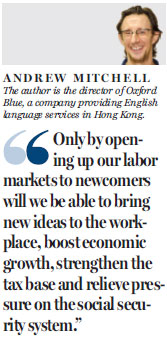Tackling the problems of an aging population requires open minds
Updated: 2016-08-04 07:46
By Andrew Mitchell(HK Edition)
|
|||||||
Editor's note: This article is the second and final part in a series dealing with issues arising from Hong Kong's aging population.
Last month I wrote a piece urging the government to tackle the issue of de facto compulsory retirement in Hong Kong. For in an era in which the population is aging rapidly with a significant number of them with most of their faculties intact, it simply makes no sense to deny people over the age of 65 the right to work.
Raising the de facto retirement age, however, is only one of many ways to tackle the problem of an aging population. Indeed, to really get to grips with the problem it is necessary to restructure not only the workforce but also the population as a whole. And that means reconfiguring the population pyramid.
The population pyramid is a visual representation of a society's population, showing the distribution of various age groups. For a developing economy the result is generally in the form of a pyramid (hence the name). However as an economy grows, fertility and mortality rates both tend to decrease, and the outcome is typically an onion-shaped "pyramid" that comes in at the bottom and gradually tapers at the top.

In the case of Hong Kong the process has seen the evolution of the population pyramid from the shape of a stupa in 1961 to that of a diamond in 2014. As the present population matures in the coming years, the bulge in this diamond will clearly rise, constituting an impending demographic crisis. For as the number of pensioners increases, the number of workers will decrease, resulting in diminishing tax returns at a time when more spending is required on the elderly.
The situation is clearly unsustainable, and successive governments have been looking at ways to rebalance the local population. The current administration, for example, has increased the child allowance by over 60 percent to HK$100,000. However the fertility rate remains less than 1.3 births per woman, well below the threshold of 2.1 required to sustain the population at current levels without immigration. Moreover the figure is as low as 1.0 when babies born to mainland women are excluded.
If the government is serious about dealing with the issues of an aging population, therefore, it needs to do more than simply throw money at the problem. For in a society where property is so expensive and flats are so small, starting a family is not only a financial concern but also one of space - particularly when both parents have full-time jobs and need to engage the services of a foreign domestic worker, who by law is required to live in.
Obviously it is extremely difficult for the government to solve the problem of affordable family housing in the short term. However there are several measures it could take to create an environment that is more conducive to having larger families.
First, it could remove the live-in requirement for domestic helpers, thereby freeing up space in the home for more children.
Second, it could enact legislation promoting more family-friendly policies in the workplace - for example, standard working hours and more generous provisions for maternity and paternity leave. It could also look into the possibility of providing creche services for working mothers, and examine the benefits of promoting flexible working arrangements such as part-time employment, career breaks for young mothers, and work breaks during school holidays.
All these measures are long-term solutions, however, and the old people of tomorrow are here today. So in addition to boosting the fertility rate, we need to be looking at expanding the workforce. To do this, we need to maximize our existing talent pool, including the children of ethnic minorities, who are often held back in the job market by their limited Chinese language skills, particularly reading and writing.
We also need to be more open to new arrivals, be they internal migrants from the mainland or immigrants from overseas. For only by opening up our labor markets to newcomers will we be able to bring new ideas to the workplace, boost economic growth, strengthen the tax base and relieve pressure on the social security system.
It is essential, therefore, that we cultivate among ourselves an inclusive mindset that shuns the parochialism of nativism and embraces the myriad opportunities of internationalism. Let us not forget that the phenomenal success of Hong Kong was built on the backs of refugees.
Immigrants are what made Hong Kong great in the first place. They will also be what makes it great in the future - no matter what the demagogues are saying today.
(HK Edition 08/04/2016 page1)